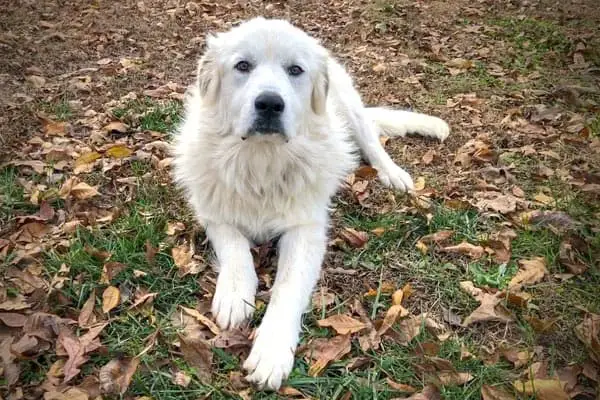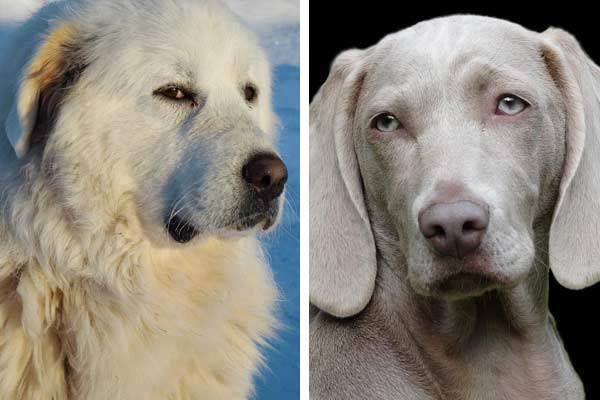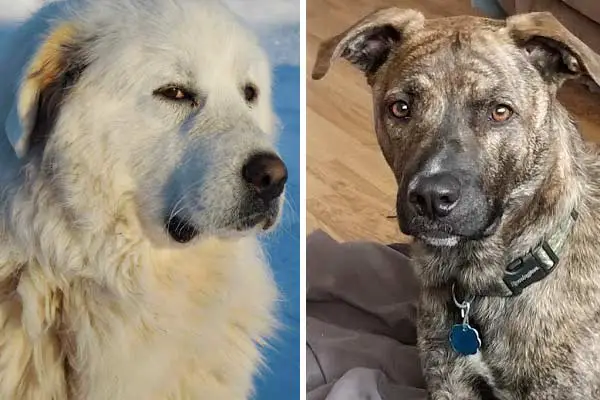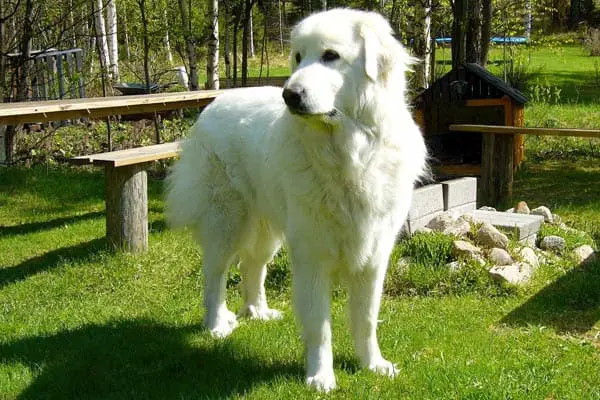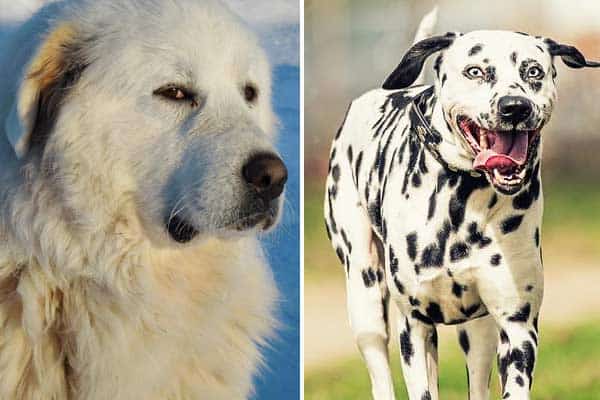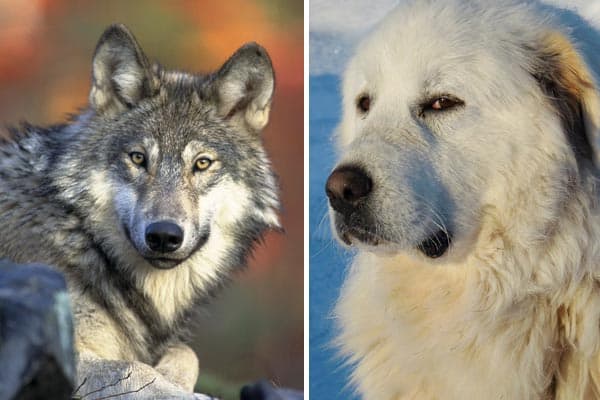Great Pyrenees vs Pitbull: Are They Completely Night and Day?
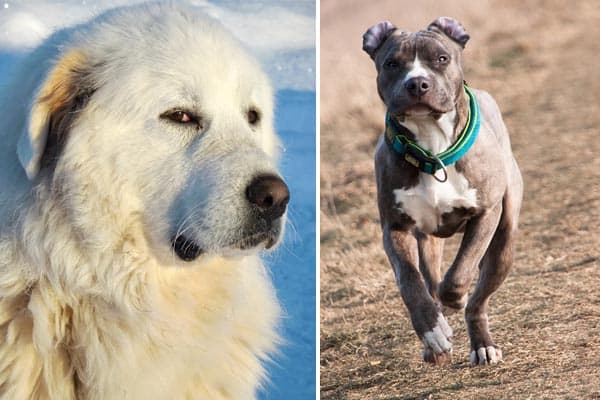
Most dog owners love to compare their favorite breeds or maybe some they have simply heard of.
The Pitbull’s notoriety makes it a favorite for comparisons. Do you wonder about the Pitbull vs German Shepherd or cane Corso or Rottweiler?
What about choosing a dog from the other side of the spectrum, such as the majestic Great Pyrenees? What would such a rare collection of contrasts and similarities look like?
The Great Pyrenees vs Pitbull is a giant breed dog primarily white in color with a thick elaborate dual coat.
In contrast, the APBT or American Pitbull Terrier is a medium-sized dog with a short coat of various colors. Pyrs belong to the working group of the AKC and guardian dogs of the UKC while Pitbulls are in the terrier class of the United Kennel Club.
Both the Pyrenees and Pitbull make affectionate, loyal, trustworthy family companions with appropriate socialization.
A varied history creates two different types of dogs
If you know what the Great Pyrenees is, you will recognize its majestic white presence anywhere.
The luxurious maned coat and plumed tail, towering and powerful figure and wedge head contrast sharply with the Pit Bull’s sleek bodybuilder physique with his round face and prominent cheeks.
You can attribute many of these differences to history and the opposing goals of the founders.
The Great Pyrenees is an ancient breed with fossil records indicating its presence in the Pyrenean region as early as 5000 years ago.
The Basques developed Pyrenean Mountain Dogs on the French side of the Pyrenees range to guard their sheep against wolves and bears.
They had herding dogs also but required a large and imposing dog that could intimidate people and animals intent on stealing from their flocks.
These dogs needed to be able to negotiate the treacherous terrain as well as withstand the harsh winters of the region.
Pit Bulls, as their name implies, were originally developed to excel in ratting and dogfighting in rudimentary manmade pits.
The Pitbull breed flourished when bullbaiting came under scrutiny with the enforcement of animal cruelty laws in the 1830s.
Before, they had been used as bull- and bear-baiting dogs but were inferior to the established Bulldog. Their talents lay in dogfighting.
As the Old English Bulldog became obsolete, terrier outcrosses dominated in the events that were easy to hide from patrolling officers.
Participants needed dogs that were scrappy, quick, powerful, courageous, and seemingly immune to pain. Ironically, they also required dogs that were docile to people so their handling would come easy.
The Pyr came to the US in 1931. Shepherd intended the Pyrs to serve in the same livestock guarding capacity that they carried out in France and other parts of Europe.
The breed received AKC recognition in 1933. It continues to also prevail as a steady and loyal family pet.
American Pit Bull Terriers arrived in America between 1845 and 1860 and carried on dogfighting.
However, the Pit Bull’s versatility was not lost on its owners, and it became an established American farm dog.
The Pit Bull served as a catch dog for stray livestock, a drover for cattle and sheep, and a family companion often associated with babysitting young children and guarding the premises.
Pit Bulls have never received recognition by the AKC but entered the UKC as the American Pit Bull Terrier in 1898.
One family branch of the Pitbull, the American Staffordshire Terrier, joined the AKC in 1936 under the promise it would never engage in dogfighting.
It is now considered a separate breed although the distinctions are often subtle. In the 1970s, the AST studbook closed and as of then, outcrossing with nonregistered Pit Bull Terriers was no longer permissible.
Is the Great Pyrenees vs Pitbull comparison all about looks?
Based on appearance, you would never confuse the Great Pyrenees with a Pitbull.
Size
- The great Pyrenees – females 25 to 29 inches tall and 85 to 120 pounds; males 27 to 32 inches tall and 100 to 160 pounds
- Pitbull – 17 to 21 inches tall and 30 to 85 pounds; females somewhat smaller than males
Conformation
- Head: GP – wedge-shaped with a slightly rounded crown; PB – broad, square-shaped, crown flat or slightly rounded
- Stop: GP – very gradual slope so barely perceptible break between forehead and muzzle; PB – moderate
- Muzzle: GP – same size as backskull, slightly tapering to the nose; PB – shorter than backskull, broad and deep
- Brow – GP – minimal with a single furrow in forehead; PB – moderate with wrinkles when the dog is at attention
- Eyes: GP – medium, almond-shaped, and at a slant, dark-rimmed and dark-colored; PB – any color acceptable accept blue, usually complements coat color, medium-sized and almond-shaped, wide-spaced
- Ears: GP – low-set, V-shaped, small; PB – high-set, semi-prick or rose, medium in size, can be cropped
- Neck: GP – medium length, slight dewlap; PB – medium in length, thick, no dewlap
- Shape: GP – slightly longer than tall; PB – slightly longer than tall, compact, almost square
- Feet: GP – rounded and close-cupped, single dewclaw on the front, double dewclaws in back; PB – rounded and well-arched, single dewclaw in front is permissible, no dewclaws in back
- Shoulders: GP – well laidback, muscled; PB – laidback and marked muscling, long and broad
- Hindquarters: muscular, balanced, straight with slight toe out of paws; PB – muscular with clear musculature, rounded
- Abdominal tuck: GP – moderate; PB – slight
- Topline: GP – level; PB – slightly sloping
- Croup: GP – slopes in a gradual curve; PB – slight slope
- Tail: GP – hangs to hock or makes the wheel over the back, heavily plumed; PB – thick at the base and tapers to a point almost reaching the hock
- Gait: GP – smooth, efficient, powerful, elegant, gliding with reach and drive; PB – effortless, jaunty, good reach and drive
Coat
- Great Pyrenees – luxurious double coat with ruff or mane of longer hair on neck and shoulders, plumes on the tail, feathers on forelegs, and pantaloons on upper hindlegs; hair short on face and ears
- Pitbull – short close coat with a harsh feel
Colors
- Great Pyrenees – base must be white; can be solid white or have shades of tan, red, gray, or badger on the ears, base of the tail, and limited patches on the body
- Pitbull – any color except merle, including white, black & tan, black, red, liver, blue, fawn, or brindle; Pitbulls of solid colors typically have flashy white markings
Comparing Temperament: It’s Not All About Looks
Both the Great Pyrenees and American Pitbull Terrier are calm, stable, gentle with the family, patient, and fearless.
Pyrenean Mountain Dogs are serious, reserved with strangers, affectionate with their families, loyal, and protective.
Although not openly hostile towards unfamiliar people, a few Great Pyrenees show no interest in warming up or expanding their circle of friends.
The American Pitbull Terrier is typically a friendly and outgoing dog although a few can be protective of family members. Contrary to the Great Pyrenees, the Pitbull is playful and people-oriented. They are also affectionate and tenacious.
Neither the Great Pyrenees nor the Pitbull is an effective guard dog by nature, although the presence of either is likely to be enough of a deterrent to ward off intruders.
Both Pyrenean Mountain Dogs and Pitbull Terriers tend to be well-mannered with and accepting of children. Pitbulls seem to enjoy them as kindred spirits while Great Pyrenees treat them as part of their flock.
Socialization is important for these dogs’ interactions with children but also with other canine pets. The Great Pyrenees can be aggressive towards other dogs because of their historical role as livestock guardians. Pitbulls can also be aggressive towards other animals but because of generations of use as fighting dogs.
Even with socialization, you will need to gauge the individual personality of your dog to determine the prudence of introducing her to new friends. As terriers, Pitbulls are not always trustworthy with cats and other small pets.
The Great Pyrenees can be a danger to other pets because of their size. Although generally gentle, never assume your Great Pyrenees will get along with all animals. Teaching them about their strength often takes several months of training.
The Great Pyrenees is a barker compared to the APBT. As part of her flock guardianship, Pyrs announce to everyone in the vicinity that they are on duty by loud and frequent barking. Moreover, the Great Pyrenees is most active at night
Pitbulls were bred to attack and fight silently, and therefore are only moderate to minimal barkers. They will pick up excessive barking as an annoying habit if left alone too much.
Great Pyrenees vs Pitbull Grooming Requirements
As you can imagine, the Great Pyrenees will have more involved grooming needs because of their luxurious dual coat. A Pit Bull has a short coat.
The Pyr will require about 30 minutes of brushing each week, which you can break up into two 15-minute sessions. Pit Bulls require weekly brushing to keep their circulation going, and you can accomplish it in five or ten minutes.
You will not spend as much time as you would think on the Great Pyrenees coat because it is soil resistant and not prone to tangling except behind the ears, under the tail, and on the upper hind leg pantaloons.
During one or two weeks of the spring and fall, you may have to brush your Great Pyrenees more frequently as they shed their undercoat.
One other difference between the breeds is the rear set of double dewclaws on the Great Pyrenees. You have to be vigilant with these claws that never touch the ground as they can curl around and cut into the pad.
Other grooming needs are the same for both breeds.
- Wipe face daily – clear eye boogers
- Check ears every few days – look for signs of infection such as redness or abnormal discharge, watch for itching
- Baths – every 6 to 12 weeks
- Clean ear – weekly gently swap any excess wax
- Nail trim – every 6 to 8 weeks
Great Pyrenees versus Pit Bull Exercise Needs
Both the Great Pyrenees and American Pit Bull Terrier can be considered working dogs although the latter is not an AKC member.
However, Pyrs do not require as much exercise as many other working breeds. Thirty to forty minutes of action daily usually suffices for these giants.
Pitbulls, on the other hand, are active dogs with the stamina to work at a trot all day. They require 60 to 90 minutes of daily exercise.
Both dog types do best when you split their exercises into two sessions during the day. You also need to supplement both with mental stimulation, which can take various forms such as paired activities or competitions, training, or puzzles.
Pyrs are great for livestock guarding and hauling competitions while Pit Bull Terriers can participate successfully in pulling contests, agility, tracking, and Shutzhund.
It is not necessary to tack on extra time for training but rather incorporate it into your exercise routine. About 20% to 30% of the activities your dog performs should be rigorous unless the weather is too warm.
Great Pyr vs Pit Bull Terrier Climate Tolerance
It does take much analytical thinking to deduce that the Great Pyrenees thrives in frigid conditions while the Pit Bull may shiver if the temperature outside approaches 30 degrees Fahrenheit.
Pit Bulls do better in warmer climates than Pyrs, enjoying temperatures even as they approach 90 degrees Fahrenheit. Pyrs will start to take issue with spring temperatures as they rise above 82 degrees Fahrenheit.
Pit Bulls can wear a jacket in winter, but it is not advisable to shave your Great Pyrenees in the summer. You will remove what insulation from the Great Pyrenees can manage with the mechanisms of her dual coat.
In the grand scheme, does bite force matter?
When a dog bites you, the trauma is exceedingly painful and the tissue damage severe. How much force a dog can apply per square inch determines the degree of damage.
Higher forces may break bones, but weaker bites are responsible for tremendous muscle, nerve, and blood vessel destruction that can still prove fatal.
It is relevant for the Great Pyrenees, rarely involved in human fatalities, and the Pit Bull, a dog responsible for the most deaths to people in the US.
A Pyr has a bite force around 500 PSI or higher while the Pit Bull’s is closer to 235 PSI. It speaks to the intent when each of these dogs bites a person. Why are Pit Bulls more lethal against people than Great Pyrenees dogs?
- Pit bulls more likely to be owned by a criminal
- A Pit Bull is more likely to live near large human populations – smaller dog, more likely to live in an apartment
- Great Pyrenees more likely to be in a country or suburban setting
- Pit Bulls are more likely to be trained specifically to be aggressive to people and other animals; Pit Bulls trained by malignant people, the Great Pyrenees is often trained in the field by other dogs
- Pit Bull is a terrier that is more likely to escalate an attack to the level of vanquishing prey; Great Pyrenees is an LGD where intimidation is the priority; both breeds can be lethal once they attack, but a Pit Bull’s trigger is often cultivated on a different level meaning he may bite with lower provocation
Realize that both the Great Pyrenees and the Pit Bull Terrier should only bite or attack people as a last resort.
Pit Bulls in their original purpose would be much less likely to bite a person than the Great Pyrenees.
Pitbulls that feature in the media and grim statistics are usually the result of abuse, irresponsible breeding, or neglect. Many have been manipulated or intimidated into taking on a role that does not fit their character.
Whereas the Great Pyrenees may face bans based on size, Pitbulls are banned based on appearance and a presumption of viciousness.
Breed-specific legislation is a major consideration before you acquire a Pit Bull Terrier as insurance companies, rental properties, dog parks, locales, and even airlines may ban them.
We observed no such restrictions on Pyrenean Mountain Dogs, but bans exist in a few countries on other LGDs like the Kuvasz and the Kangal (Anatolian Shepherd).
Training the Great Pyrenees vs Pitbull
We can presume that the Pit Bull’s working intelligence is going to be very similar to that of the American Staffordshire Terrier.
It puts her intelligence ranking about obedience and working at 34th out of 137 purebred AKC-registered dog breeds compared to No. 64 for the Great Pyrenees.
While both breeds can show a good deal of stubbornness, Pitbulls tend to be more trainable than the Great Pyrenees.
Pitbull Terriers are willing to please with residual obstinate behavior from their Bulldog heritage and independent thinking from their Irish Terrier and Black and White Terrier ancestors.
The Great Pyrenees’ independence comes from generations of cultivation because the ability to make decisions without human input is paramount for a livestock guardian dog.
Training results for both breeds are most successful with a mix of positive reinforcement, repetition, from leadership, and well-timed corrections.
Great Pyrenees dogs will require more repetitions and more convincing, but harsh methods and reprimands are not effective on either dog.
Both breeds are sensitive, the Great Pyrenees especially so considering she does not seem extremely interested in pleasing her handlers.
Feeding Great Pyrenees vs Pitbull Terrier
Great Pyrenees dogs eat more than Pitbulls, of course, because they are larger. However, they require fewer calories per pound due to a slower metabolism. Moreover, their ancestors were bred to work efficiently with less food.
The Great Pyrenees should eat 20 to 26 calories per pound of body weight daily while the Pitbull requires 25 to 33.
All dogs need proteins and fats, ideally sourced from meat. Many commercial dog food recipes use high-quality plant oils instead of animal fats with no ill effects.
Carbohydrates remain a topic of hot debate in dogs but may include green vegetables like spinach, kale, broccoli, potatoes, grains, fruits, or legumes such as peas.
Puppies may require up to three times the amount of food that adults eat.
Maintaining an Identity
When you hear the term Great Pyrenees, you do not doubt what breed of dog it refers to. However, Pitbull has come to include at least three different dog breeds, and some institutions loosely group many Bully dogs.
Breeds Often Identified as Pitbulls
- American Bull Terrier
- American Staffordshire Terrier
- Staffordshire Bull Terrier
Some Bully breeds that are grouped with Pitbulls for banning and insurance purposes include the following:
- English Bulldog – not on all lists
- American Bully
- American Bulldog
- Boxer
- Mastiff group – Cane Corso, English Mastiff, Dogo Argentino, Boerboel, Tosa Inu
- Bull Terrier
- Olde English Bulldogge
- Bandog
Great Pyrenees vs Pitbull Health
The Great Pyrenees can live 10 to 12 years compared to the Pitbull’s 12 to 14 years.
Great Pyrenees Common Health Issues
- Ear infections
- Joint abnormalities – luxating patella (floating kneecap), hip dysplasia, panosteitis (inflammation of long bones in rapidly growing pups)
- Osteosarcoma (bone cancer)
- Bloat – stomach swells with gas or fluid and rotates
- Cataracts
- Spinal muscular atrophy – muscles around spine start wasting
Most Prevalent Pitbull Problems
- Progressive retinal atrophy (PRA) – the genetic condition of part of the eye responsible for night and color vision; will eventually lead to complete blindness
- Hip dysplasia
- Hypothyroidism – low thyroid hormone which causes dry skin and lethargy
- Suppressed immune system when the young – additional risk of parvovirus and Demodex (naturally occurring mite that overproliferates, causing hair loss)
- Uric bladder stones
- Skin ailments – ichthyosis (dry, flaky, itchiness) or zinc-dependent dermatosis (affected dog does not absorb zinc effectively)
- Allergies
Great Pyrenees vs Pitbull: It’s a Wrap
- The Great Pyrenees is roughly two to three times the size of a Pitbull
- Great Pyrenees desired coat is solid white but can have limited markings, especially on the ears, and near the base of the tail
- As you can see, Pitbulls can be many colors – featured are chocolate and white, tan and white, and blue with white among others
- Pitbulls usually have rose or semi-prick ears; the Great Pyrenees’ ears are small or medium relative to the size of her head; you will see an example of cropped ears in the Pitbull video
- Notice the thick luxurious coat of the great Pyrenees vs the Pitbull that has a short hard coat
